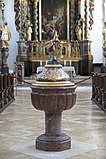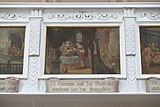St. Lorenz (Munich)
The Catholic parish church of St. Lawrence in Oberföhring in Munich district Bogenhausen is a baroque church from the late 17th century. The church consecrated to St. Laurentius is one of the protected architectural monuments in Bavaria.
location
St. Lorenz is located in the old core of Oberföhring near the edge of the Isar high bank. The church tower with the saddle roof can be seen from afar and is a landmark of Oberföhring. The church is surrounded by a walled cemetery.
history
Oberföhring already owned a parish church in the Middle Ages, which was built in 1315, the first church in Oberföhring is mentioned in a document from 822. In 1678 this had become so dilapidated that it was demolished and replaced by a new building by a master builder from the Schliersee artist family Zwerger. The new building was consecrated in 1680. In 1893 the tower was also rebuilt. A comprehensive interior renovation took place in two steps between 2015 and 2018.
architecture
The church consists of a nave with a floor area of about 35 × 11 meters. A smaller porch is placed in front of the entrance side on the west facade, on the right-hand side of which the square tower with a gable roof stands.
The high baroque building has a stucco cap barrel and a wall structure with fluted pilasters . The nave has four bays , the only slightly drawn-in choir ends in a straight line. The rich stucco on the vaults, window reveals and frames consist of angels (some with tools of passion), tendrils, spirals, rosettes and garlands. On the chancel arch the emblem of Freising prince-bishop are Albrecht Sigismund of Bavaria mounted who built the baroque new building.
Altars
- The high altar with its four winding columns was created in 1736/37. The statues of the apostles Peter and Paul , which stand at the side between the columns, were taken from the earlier reredos from 1648. The altarpiece was painted by Karl Diebitsch in 1964 . It depicts the martyrdom of the patron saint of the church and is a copy of a painting by Titian that hangs in the Jesuit church in Venice .
- The two side altars were created by Benedikt Hauser in 1764. The painting on the left altar dates from the early 17th century and was originally in the St. Emmeram pilgrimage chapel, which was demolished in 1820 . The picture shows the holy Emmeram between angels, the frame is a work by Egid Quirin Asam from the year 1739. To the side are the assistant figures Johannes Nepomuk and Johannes von Krakau , on the altar bar stands Saint Joseph with the baby Jesus, who is carved by one Rococo cartridge is framed. The right altarpiece contains the figure of Saint Sebastian , flanked by Saints Leonhard and Wendelin . In the cafeteria, also framed by a rococo cartridge, there is a Madonna and Child.
- On the central nave walls are two more rococo altars by Thomas Ayrundschmaltz, whose reredos are dedicated to the crucifixion of Christ (with Mater Dolorosa ) and the flagellation of Christ . The figures of the crucified and the Mater dolorosa date from the early 17th century, the figure of the Scourge Savior is a work by Johann Georg Greiff from 1746.
Further equipment
- A rosary Madonna from 1680 hangs on the choir arch .
- The bas-relief with the crucifixion scene is dated around 1520.
- A baroque Pietà from the end of the 17th century stands on a console at the foot of a cross .
- The simple baroque pulpit was made at the end of the 17th century. The painting on the back wall depicts Jesus as Salvator mundi (savior of the world).
- The baptismal font was created in 1767 by the stonemason Johann Nepomuk Einsele. The lid is crowned by a small rococo figure of John the Baptist .
- On the parapet of the lower gallery there are seven oil paintings from the early 17th century with scenes from the life of St. Lawrence.
- The Stations of the Cross were painted around 1900, the frames are based on the Rococo style.
organ
In 1986 the church received a new organ with a mechanical action . The organ with 29 registers was built by master organ builder Franz Heinze (1931–2011) from Nuremberg . The carved veil boards were designed and made by the freelance sculptor Carsten Lewerentz from Staudach-Egerndach. The organ's disposition is:
|
|
|
|||||||||||||||||||||||||||||||||||||||||||||||||||||||||||||||||||
- Coupling : II / I, I / P, II / P
- Playing aids : electr. 32-fold setter combination
- Notes: Sharper , mech. Action action, mech. and electr. Register action
literature
- Georg Dehio : Handbook of the German art monuments. Bayern IV: Munich and Upper Bavaria. 2nd edition, Deutscher Kunstverlag, Munich 2002, ISBN 3-422-03010-7 , pp. 706–707.
- Josef H. Biller, Hans-Peter Rasp: Munich Art & Culture . Ludwig Verlag, Munich 2003, pp. 296-297.
Web links
- St. Lorenz. St. Lorenz - Parish Association of St. Thomas and St. Lorenz
- Treasure book St. Lorenz. St. Lorenz Oberföhring
- Catholic parish church Sankt Lorenz. on the website of the Association for District Culture in the Munich Northeast eV
Individual evidence
- ↑ List of monuments for Munich (PDF) at the Bavarian State Office for Monument Preservation, monument number D-1-62-000-4672 .
- ↑ Bavarian organ database online
Coordinates: 48 ° 10 ′ 15 ″ N , 11 ° 37 ′ 27 ″ E













